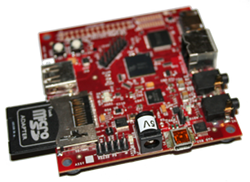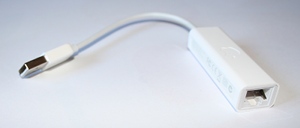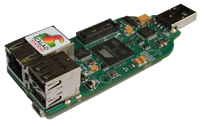Note: these instructions are now out of date and refer to URLs which no longer exist. See the elinux.org wiki for more recent instructions.
These instructions are derived from Embinux.org’s Android Porting Guide to Beagle Board (the corresponding web page no longer exists), based on their work to port Android on the Beagle board. They correct multiple inaccuracies in this guide, and also add many useful details.
These instructions were tested on xubuntu 9.04. There shouldn’t be many differences if you use other recent Ubuntu or Debian versions.
Install needed software packages
At the time of this writing, note that Android requires Sun’s Java5 JDK, and doesn’t support the Java6 one.
apt-get update
apt-get dist-upgrade
apt-get install git-core bison sun-java5-jdk flex g++ zlib1g-dev
apt-get install libx11-dev libncurses5-dev gperf uboot-mkimage
Android also uses its own repo script as a git front-end:
mkdir -p ~/bin
cd ~/bin
curl https://dl-ssl.google.com/dl/googlesource/git-repo/repo > repo
chmod +x repo
We are also going to need a 2007q3 toolchain from Code Sourcery
cd
wget http://www.codesourcery.com/sgpp/lite/arm/portal/package1787/public/arm-none-linux-gnueabi/arm-2007q3-51-arm-none-linux-gnueabi-i686-pc-linux-gnu.tar.bz2
cd /opt
sudo tar jxf arm-2007q3-51-arm-none-linux-gnueabi-i686-pc-linux-gnu.tar.bz2
You could also get this toolchain from our website:
cd
wget /pub/demos/beagleboard/android/arm-2007q3-51-arm-none-linux-gnueabi-i686-pc-linux-gnu.tar.lzma
cd /opt
sudo tar --lzma -xf ~/arm-2007q3-51-arm-none-linux-gnueabi-i686-pc-linux-gnu.tar.lzma
Download sources
Our instructions create a directory in your home directory, but of course, it can be placed anywhere!
mkdir ~/beagledroid
cd ~/beagledroid
repo init -u git://labs.embinux.org/repo/android/platform/beaglemanifest.git/
repo sync
Caution: this can take a lot of time, as this downloads and extracts 2.4 GB of data. On a fast workstation with a 500KB/s Internet connection, it took about 90 minutes.
Building Android
make
If your workstation has multiple CPUs, you could save a lot of time by running multiple jobs in parallel:
make -j 4
On our machine, this took about 4 hours!
Building the kernel
export CC_PATH=/opt/arm-2007q3/bin/arm-none-linux-gnueabi-
cd ~/beagledroid/kernel
../vendor/embinux/support-tools/beagle_build_kernel.sh
Copying the Android root filesystem
Android’s root file system is generated in ~/beagledroid/out/target/product/generic
cd ~/beagledroid/out/target/product/generic
mkdir ~/beagledroid/rootfs
cp -a root/* ~/beagledroid/rootfs/
cp -a system/* ~/beagledroid/rootfs/system/
cd ~/beagledroid/rootfs
sudo chown -R root.root .
sudo chmod -R a+rwX data system
Formatting an MMC/SD card
First connect your card reader to your workstation, with the MMC/SD card inside. Type the dmesg command to see which device is used by your workstation. Let’s assume that this device is /dev/sdb
Type the mount command to check your currently mounted partitions. If MMC/SD partitions are mounted, unmount them.
In a terminal edit partitions with fdisk:
sudo fdisk /dev/sdb
Delete any existing partition with the d command.
Now, create the boot partition:
Command (m for help): n
Command action
e extended
p primary partition (1-4)
p
Partition number (1-4): 1
First cylinder (1-239, default 1): 1
Last cylinder, +cylinders or +size{K,M,G} (1-239, default 239): +64M
Change its type to FAT32:
Command (m for help): t
Selected partition 1
Hex code (type L to list codes): c
Changed system type of partition 1 to c (W95 FAT32 (LBA))
Using the n command again, create a second partition filling up the rest of your card (just accept default values).
Now, format the partitions in your card:
sudo mkfs.vfat -n beagleboot -F 32 /dev/sdb1
sudo mkfs.ext3 /dev/sdb2
Remove and insert your card again. Your new partitions should be mounted automatically.
Copying data to the MMC/SD card
Start by copying the X-loader and U-boot on the first partition.
cd /media/beagleboot
wget /pub/demos/beagleboard/android/MLO
/pub/demos/beagleboard/android/u-boot.bin
cp ~/beagledroid/kernel/arch/arm/boot/uImage .
Now copy the Android root filesystem to the second partition (assuming it is mounted on /media/disk:
sudo rsync -a ~/beagledroid/rootfs/ /media/disk/
Finish by unmounting your MMC/SD partitions:
sudo umount /media/beagleboot
sudo umount /media/disk
Boot setup
The last thing left to do is to specify how the board boots Linux.
Plug the Beagle board on your computer, and also connect it to a DVI-D monitor. Start minicom (corresponding to Hyperterminal in Windows) on /dev/ttyS0, or on /dev/ttyUSB0 if you are using a serial to USB adapter. Power up the board.
First, stop Minicom from truncating long lines by typing [Ctrl] [a] followed by z and w.
In the U-boot prompt, make the board boot automatically on the MMC/SD card:
setenv bootcmd 'mmc init;fatload mmc 0 80000000 uImage;bootm 80000000'
saveenv
Now set the kernel command line arguments:
setenv bootargs console=ttyS2,115200n8 noinitrd root=/dev/mmcblk0p2 video=omapfb.mode=dvi:1280x720MR-24@50 init=/init rootfstype=ext3 rw rootdelay=1 nohz=off androidboot.console=ttyS2
You may need to adapt the video settings to the capabilities of your DVI display. You should now see Android boot!

 150MHz RDC CPU, Intel 486SX compatible
150MHz RDC CPU, Intel 486SX compatible At the time of this writing, most documentation that you can find on the web about the Beagle board will tell you that you need to take special preparation steps if you wish to boot your board on an MMC/SD card:
At the time of this writing, most documentation that you can find on the web about the Beagle board will tell you that you need to take special preparation steps if you wish to boot your board on an MMC/SD card:
 2 USB 2.0 host ports, allowing to connect any type of device. In particular, we are thinking about USB mass storage and webcam devices.
2 USB 2.0 host ports, allowing to connect any type of device. In particular, we are thinking about USB mass storage and webcam devices.